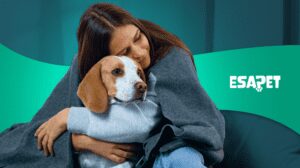Narcolepsy Service Dog: Training, Assistance, and How to Get One in 2026

Service dogs are amazing companions trained to help people with various health conditions. They provide practical support and emotional comfort, improving their handlers’ quality of life.
Narcolepsy is a condition that causes excessive daytime sleepiness and sudden sleep attacks. It can be very challenging to manage. A narcolepsy service dog can help those affected by offering specific support tailored to their needs.
This post will explore what narcolepsy service dogs do, how to train them, and how you can get one. Understanding their role can make a significant difference for individuals with narcolepsy.
What is Narcolepsy?
Narcolepsy is a persistent neurological condition that impairs the brain’s capacity to regulate sleep-wake cycles. People with narcolepsy may feel relaxed when they get up. However, they remain tired for the majority of the day.
Narcolepsy is a lifelong condition, and its symptoms vary in intensity over time. Individuals may face psychological, social, and cognitive challenges without diagnosis and treatment. Narcolepsy can impact academic performance, work, social interactions, and daily activities.
There are two main types of narcolepsy:
Narcolepsy with Cataplexy
Individuals have low levels of the hormone hypocretin or experience cataplexy and excessive daytime sleepiness.
Narcolepsy without Cataplexy
Individuals endure extreme daytime sleepiness. However, they do not have muscle paralysis caused by emotions.
Narcolepsy Symptoms
- Irregular sleep patterns
- Excessive daytime sleepiness
- Cataplexy (sudden loss of muscle tone)
- Hallucinations at the beginning of the night or upon awakening
- Sleep paralysis
Narcolepsy Treatment
Unfortunately, there is no cure for narcolepsy. However, there are treatments available that can help manage symptoms.
Medications such as Armodafinil, Sodium Oxybate, Modafinil, and amphetamine-like stimulants are commonly used. These treatments can help reduce excessive daytime sleepiness and improve nighttime sleep quality.
Besides medication, lifestyle changes and supportive measures, like having a narcolepsy service dog, can improve the quality of life for those affected.
Service dogs can assist by providing alerts and physical support. A trained service dog helps to manage the daily challenges of living with narcolepsy.
What Are Service Dogs?
Service dogs are specially trained animals that assist people with disabilities. They help people with physical, sensory, psychiatric, intellectual, or mental health conditions.
Service dogs can perform specific tasks to help their handlers live more independently. These tasks include:
- Guiding the visually impaired
- Alerting individuals with hearing loss
- Helping those with narcolepsy
- Fetch medication, phones, or other essential items
Service dogs provide many benefits, including increased independence, safety, and emotional support.
They help their handlers perform daily activities, reduce anxiety, and improve well-being. The extensive training process ensures the dogs can handle situations and provide assistance.
Emotional Support Animals
Emotional support animals (ESAs) help people with mental illnesses. They help by providing comfort and assistance. Unlike service dogs, ESAs do not need training and are not granted the same rights to public access. Their primary role is to offer emotional stability through companionship and can be formally registered with an ESA letter.
Psychiatric Service Dogs
Psychiatric service dogs are trained to perform specific tasks for individuals with a chronic brain disorder or psychiatric disorder. These disorders include:
- PTSD
- Depression and anxiety
- Bipolar Disorder
- Panic Attack
- Narcolepsy
Psychiatric service animals can remind their handler to take medication or provide support during emotional distress or panic attacks.
Service Animals
Service animals, including therapy dogs and narcolepsy alert dogs, are individually trained to assist with specific disabilities. They have public access rights and can go with their handlers to most places.
A service animal undergoes rigorous training. This training ensures that the animal can effectively perform its tasks and support its handlers.
How Can Service Dogs Help With Narcolepsy?
Service dogs can help individuals with narcolepsy by providing alerts, support, and assistance during sleep attacks. They get training to recognize the signs of an impending sleep attack and respond.
Service Dogs and Their Benefits for Narcolepsy
Service dogs provide essential support for those with narcolepsy, enhancing their quality of life and offering a reliable companion to explore daily challenges. Here are some of the benefits they bring to those living with this neurologic disorder:
Narcolepsy Alert Dog
These dogs can detect the early signs of a sleep attack and alert their handler. It helps provide time to find a safe place to rest.
Safety Assistance
Service dogs help guide their handlers to a safe spot during a sleep attack. This action helps prevent injuries from sudden falls.
Medication Reminders
They can remind their handler to take medication at specific times. This helps manage symptoms more effectively.
Emotional Support
An emotional support dog’s presence can reduce anxiety and high stress. They can help improve overall mental health.
Improved Sleep Patterns
Service dogs help manage narcolepsy symptoms. They contribute to more regular sleep patterns and better overall sleep quality.
Narcolepsy Service Dog Training
Training a narcolepsy service dog involves several steps to ensure it can assist its handler. There are many ways to get a narcolepsy service dog, and each option has its own benefits.
- Purchase a Trained Service Dog: Reputable training institutions specialize in training dogs to meet the specific needs of individuals with narcolepsy. This ensures the dog is professionally trained and ready to provide support.
- Self-Training: This option can be more affordable and allow you to build a strong bond with your dog. Various resources, such as online courses, can guide you. They cover essential tasks like retrieving medication and public access training.
- Professional Trainer: Working with a local professional dog trainer can provide personalized training and support. This approach combines expert guidance with the opportunity to participate in your dog’s training.
- Organizations for Assistance: Organizations like Assistance Dogs International can help you find reputable training programs and schools in your area. These organizations offer resources and support to ensure you get the best training for your service dog.
How To Qualify For A Service Dog If You Have Narcolepsy
Qualifying for a service dog if you have narcolepsy involves a few essential steps. Here’s a simple guide to help you understand the process.
- Obtain a Diagnosis: First, you need a formal diagnosis of narcolepsy from a healthcare professional. This confirms your condition and helps determine your service dog’s tasks.
- Age Requirement: Generally, you must be 12 years old to qualify for a service dog. However, if you need a service dog for a child with autism, the age requirement can be between six and twelve years.
- Assess Your Needs: Consider how a service dog can assist you with narcolepsy. This can include alerting you before a sleep attack, retrieving medication, or guiding you to a safe place during an episode.
- Living Environment: Ensure that you live in a stable home environment. This stability is crucial for the well-being of both you and your service dog.
- Participation in Training: You need to be physically and mentally capable of participating in the training process. This training process can take up to one hour per day. This involvement is important for building a strong bond with your service dog.
- Handling the Dog: You should be able to command and handle a service dog independently. This means you should be able to manage the dog’s needs and behaviors effectively.
- Financial and Emotional Commitment: Prepare yourself to meet a service dog’s physical, emotional, and financial needs. Owning a service dog is a significant responsibility that requires a long-term commitment.
- No Other Dog: You should not have another dog in the home, although other animals are generally allowed. This helps avoid conflicts and ensures the service dog can focus on assisting you.
What It Costs To Get A Service Dog
Getting a service dog can be quite an investment. The cost typically ranges from $15,000 to $30,000. This cost covers the dog’s training to perform specific tasks for its handler. Some organizations offer financial assistance or fundraising options to help with these expenses. Lear more about them in our dedicated article on Service Dog Costs.
How to Get a Service Dog
Getting a service dog involves several steps. Here’s a straightforward guide to help you through the process.
- Get a Diagnosis: First, get a formal diagnosis from a healthcare professional. This step is crucial to confirm your need for a service dog.
- Research Organizations: Look for reputable organizations that train and provide service dogs. Assistance Dogs International is a good place to start, as they can direct you to local programs.
- Apply for a Service Dog: Apply to the organization of your choice. The application process includes providing medical documentation and details about your daily needs.
- Interview and Assessment: You may need an interview or assessment to determine your suitability for a service dog. This step helps the organization match you with the right dog.
- Training Process: Engage in the training process, including the dog’s training and your own training sessions. This ensures you can handle the dog and that the dog can meet your specific needs.
- Home Visit: Some organizations conduct home visits to ensure your living environment suits a service dog.
- Final Approval and Placement: You will receive your service dog once everything is in order. Be prepared for ongoing training and adjustment periods.
For more detailed information and to get the necessary documentation, check out our article on Psychiatric Service Dog Letter, which might be needed in some cases.
Get Your Legit PSD Letter in 3 Easy Steps
Getting your Psychiatric Service Dog (PSD) letter through ESA Pet is simple and straightforward. Here’s how you can do it:
Complete the Simple 2-Minute Screening
Take a quick survey and answer a few basic questions. This survey helps mental professionals determine if you qualify for a service animal. Rest assured, your responses are private and only accessible to authorized personnel.
Connect With a Licensed Healthcare Professional
After submitting a secure payment, you’ll connect with a licensed professional in your state. They will assess your mental and emotional health to decide if a service dog would benefit you.
Get Your PSD Letter
If approved, you will receive a signed PSD letter from the professional. You will receive a digital copy of your PSD Letter within three days.
Get your Official PSD Letter Consultation from a licensed therapist.
Get PSD Letter NowHow To Choose a Service Dog For Narcolepsy
Choosing the right service dog for narcolepsy is important. Here are some several factors to consider:
- Temperament: Look for a dog with a calm and stable temperament. They should be able to stay awake and focused and not be easily distracted.
- Size: Consider the dog’s size. A medium-sized dog is often ideal, as it is large enough to perform tasks but not too big to handle.
- Training Capability: Ensure the dog you select can be trained for specific tasks. These tasks can include alerting you before a sleep attack or retrieving medication.
- Compatibility: The dog should complement your lifestyle and home environment. Consider your activity level and the space available at home.
- Health: Choose a healthy dog with a good medical history. This ensures that it will serve you well for many years.
FAQs about Service Dog for Narcolepsy
Can You Get a Service Dog if You Have Narcolepsy?
Yes. You can get a service dog if you have narcolepsy. You need a formal diagnosis and must meet certain criteria. This includes being able to participate in training and handle the dog independently.
What Is the Best Dog for Narcolepsy?
The best dog for narcolepsy is typically a medium-sized breed with a calm temperament and high trainability. Breeds like Labradors, Golden Retrievers, and Poodles are often good choices.
How Do Dogs Sense Narcolepsy?
Most dogs can sense narcolepsy through changes in their handler’s behavior, scent, or physiological signals. They get training to recognize these cues and alert their handlers.
Can Narcolepsy Be Observed in Dogs?
Narcolepsy can occur in dogs, though it is rare. Symptoms in dogs include sudden collapse and daytime sleepiness. If you suspect your dog has narcolepsy, consult a veterinarian for proper diagnosis and treatment.
Conclusion
Service dogs for narcolepsy provide essential support, from alerting their handlers to guiding them to safe locations. They also offer emotional comfort, reducing anxiety and stress. This contributes to improved sleep patterns and overall well-being.
There are many options for obtaining a service dog, including dogs trained by professionals or self-training with online courses. With the right approach, a Narcolepsy Service Dog can be a life-changing companion.

Dogs, Emotional Support Animal, Travel
How Many Service Animals Can You Have? G...
Julia Oliveira
Dec 12 2025

Dogs, Emotional Support Animal
Pet Insurance Coverage: What Pet Insuran...
Andre Gregatti
Dec 31 2025







